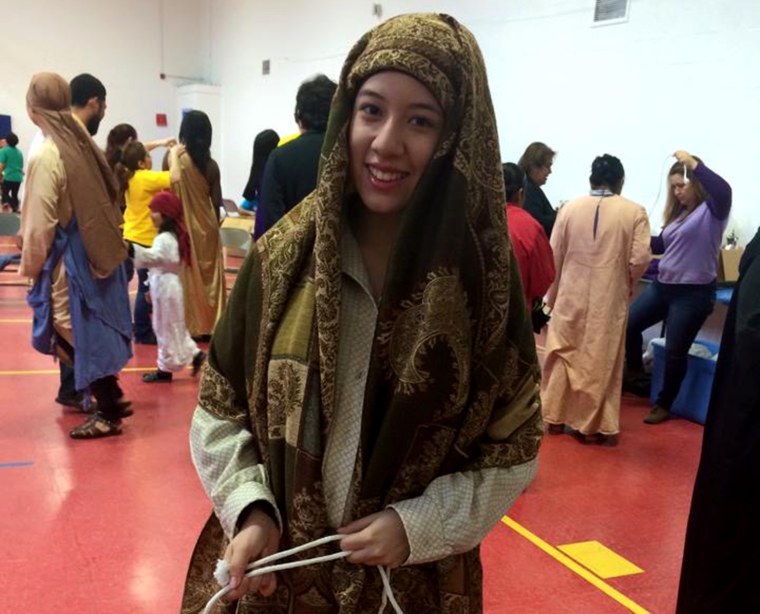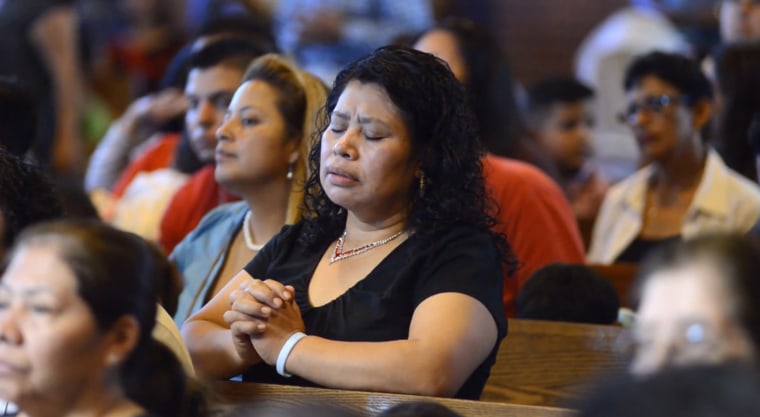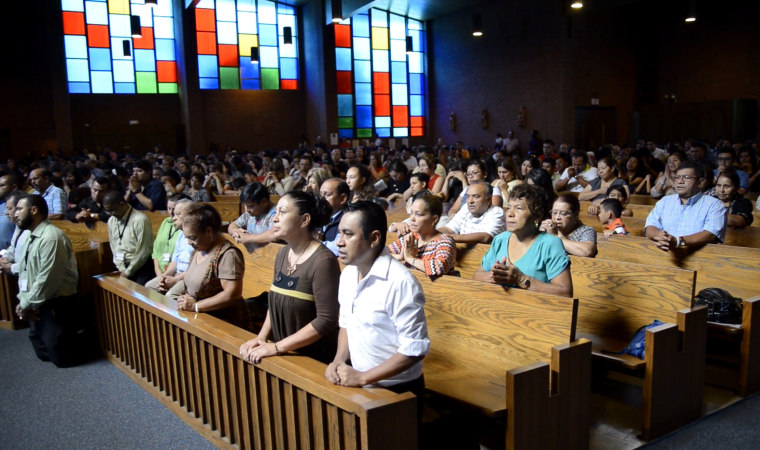Two to three years after Claudia Quiñones “forgot about being a Catholic,” she is back in the fold, singing as an alto in the choir, attending Mass regularly and feeling she has something to believe in.
The church, Our Lady of Sorrows Church in Takoma Park, Maryland, is a family affair for the 20-year-old. Her cousin plays piano. Her aunt prepares flowers every weekend. They are the ones who nudged her back to Mass.
“I come from Bolivia and in Latin America, people are very religious there and when I migrated to the U.S., I completely forgot about being a Catholic and little by little I’ve been going back,” she said. “I felt the same welcome feeling I had when I used to go to church. I felt safe. I realized I needed that in my life.”

Quiñones is among the lucky faithful who snagged a ticket through a lottery for the Mass that will be spoken in Spanish by Pope Francis at the Basilica of the National Shrine of the Immaculate Conception in Washington D.C. on Thursday. She gave that ticket to her mother and will try to see the pope when he makes his way from the White House to a D.C. church.
As a young Latina Catholic, Quiñones is a central thread in an ongoing revitalization of the church by Latinos Pope Francis is highlighting with his trip to Washington, D.C.
Guzman Carriquiry, vice president of the Pontifical Commission for Latin America, told The Associated Press that Pope Francis, on his U.S. trip, would uphold Latinos not as an “add on” to church life, but as the heart of American Catholicism.
“I’m really nervous. I want to see him. I want to hear him and I want to be inspired by his word,” said Quiñones, who is a recipient of Deferred Action for Childhood Arrivals and works as a community organizer for CASA of Maryland.
In the 1960s, just 10 percent or less of Catholics were Latinos, said Hosffman Ospino, an assistant professor of Hispanic ministry and religious education at Boston College.

Today, 43 percent of all U.S. Catholics are Hispanic. But more important, about 60 percent of Catholics under the age of 18 are Latino. And though the church is being significantly shaped by immigrants, it is this generation of young Latinos born in the U.S. that is having greater impact, Ospino sad.
“The present and future of Catholicism in the U.S. is intimately linked to the Latino experience. Its vibrancy and its potential to move into the future is in U.S. born Latinos,” Ospino said.
That demographic shifts in the U.S. are taking hold just as Pope Francis bring his two-year-old papacy to the U.S. are to some an important - and hopeful - turn of events.
Bianca Garcia, a 30-year-old Austin, Texas attorney and a lifelong Catholic said Pope Francis has “re-energized young Latino Catholics and former Catholics, through his example of humility and charity, such as providing showers for Rome’s homeless.
“His message of helping the poor and being selfless and being Christ-like resonates with a lot of young people who are trying to make the world a better place,” said Garcia, who attends and volunteers at St. Ignatius Martyr Catholic Church.
“The present and future of Catholicism in the U.S. is intimately linked to the Latino experience," says one Hispanic scholar.
“We should all hope to be like him,” said Garcia, who was born in the U.S. “He understands that young people love the tradition of the Catholic Church, but also love the idea of making it relatable to people in need. So faith is important, but how we put that faith into action is also important. He’s given us concrete examples of how we can live our lives in small ways that reflect our faith.”
In general, U.S. born Catholics are not Catholic in the same ways as their parents are, said Ospino. Many are leaving behind the devotional life and processions that shape the the spirituality of immigrant Catholics.
"But as parents pass on their faith and culture, something is retained in these young Latinos that has the potential to make different cultures vibrant. Is the Catholic church ready and willing to grow with Hispanic youth," said Ospino.
A poll by The Catholic University of America’s Institute for Policy Research and Catholic Studies and Faith in Public Life found the highest levels of enthusiasm for the pope among Latino Catholics.
Eighty-five percent had a favorable opinion of him and 90 percent had agreed he is leading the church in the right direction.
Quiñones said she calls herself a Catholic “with liberal tendencies.” On the day she talked to NBC News, Quiñones had been meeting with parents of schoolchildren through CASA’s Learning Together program, which helps parents with the education of their children so their children succeed in school.
“The Bible says to help thy neighbor, and I feel I’m doing that going out and helping these people who are many times lacking the services, and they need help. I’m helping them out and that makes me happy,” she said.
As an immigrant with family members of mixed legal status – some are citizens, others are not legally in the U.S. — she also sees the pope’s compassion as very Latin American.
Latin Americans “are warm and very welcoming. He’s showing that to the world, that he’s caring, he wants to make a difference.”
Despite the potential for the church from young Latinos, the church is moving slowly to adjust and incorporate them, experts said.

“Latino Catholics are growing in number, we all know that. But, most leadership positions in American Catholicism are not held by Latinos and sometimes the ministries are temporary,” or are seen as an ethnic program to be operated until Latinos become mainstream, said Timothy Matovina, a theology professor and co-director of University of Notre Dame’s Institute for Latino Studies.
There were 17,483 Catholic parishes in the U.S. last year with about 67 million Catholics connected to them, according to the Center for Applied Research in the Apostalate based at Georgetown University in Washington, D.C. About 5,000 have Hispanic ministries. But Ospino said the effort to engage the growing Latino population has been weak, with just four Catholic parishes having a youth group oriented to Hispanic Catholic youth. Just 3 percent or less of school age Latinos in the country are in Catholic school, Ospino said, citing findings of his recently completed national study of Catholic parishes with Hispanic ministries.
Despite the potential for the Catholic church from young Latinos, the church is moving slowly to incorporate them, say some Hispanic scholars. The Pope's visit "can energize the base.".
Additionally, about 20 percent of young Hispanics live in “at-risk conditions” — exposed to or involved in gang activity, extreme violence and other dire problems, he said.
“As a church we are doing very little to reach out strategically,” he said. “We can do more. We must do more.”
More Latino Catholics need to attend college and become leaders in the church and be involved in decision-making. His hope is that the pope’s visit will elevate discussion of Hispanic Catholics and young Latinos.
On the website for Notre Dame’s Institute of Latino Studies, Matovina states that despite tensions, Hispanics and their fellow Catholics have great potential to enrich each other.

To that end, Pope Francis’ visit also will serve as a rallying of the troops, those Catholics who not only attend church but volunteer, teach its Sunday school classes, serve as ushers, choir director and lectors. And not just those in the U.S.
“What the pope’s visit will do is energize the base,” Matovina said. “A number of Latinos in Latin America have gone to other or no religion, at the same time that has strengthened the convictions of those who have remained. They have to have a reason for remaining."
Gabriel Quintas, 21, is not an adoring fan of Pope Francis, but he said he still considers the pope’s planned visit to the U.S. inspiring because it’s not the traditional place a pope would visit.
Quintas, born in Miami, was 15 when he became religious, drawn by what he said was the destruction of the family and the ignoring of Christian morality.
“It was a product of the Holy Spirit working within me,” he said. “I realized the church contains the deposit of faith and the only truth on this Earth.”
The pope’s visit to the U.S. shows he cares for the church and America, Quintas said.
“It’s inspiring to me because it shows he cares for all his flock,” Quintas said. “It shows the desire that he wants to make sure the church is well founded in all places in the world.”
NBC contributors Juan Castillo in Austin, Texas and Carmen Sesin In Miami contributed to this report.
